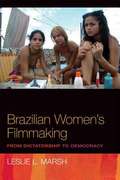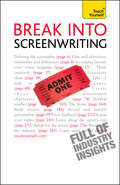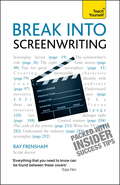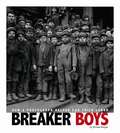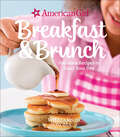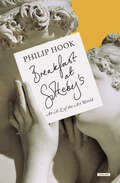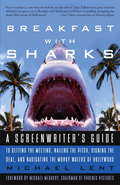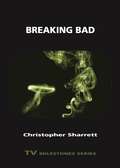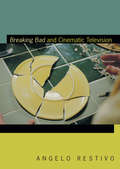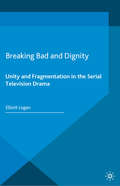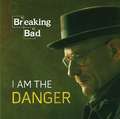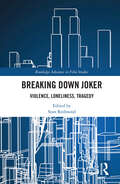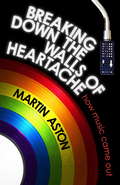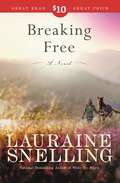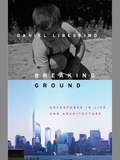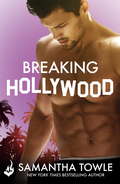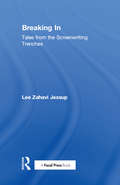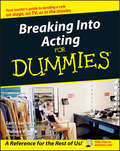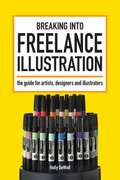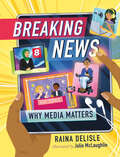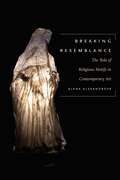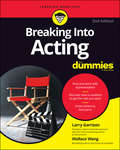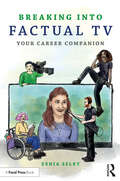- Table View
- List View
Brazilian Women's Filmmaking: From Dictatorship to Democracy
by Leslie MarshAt most recent count, there are no fewer than forty-five women in Brazil directing or codirecting feature-length fiction or documentary films. In the early 1990s, women filmmakers in Brazil were credited for being at the forefront of the rebirth of filmmaking, or retomada, after the abolition of the state film agency and subsequent standstill of film production. Despite their numbers and success, films by Brazilian women directors are generally absent from discussions of Latin American film and published scholarly works. Filling this void, Brazilian Women's Filmmaking focuses on women's film production in Brazil from the mid-1970s to the current era. Leslie L. Marsh explains how women's filmmaking contributed to the reformulation of sexual, cultural, and political citizenship during Brazil's fight for the return and expansion of civil rights during the 1970s and 1980s and the recent questioning of the quality of democracy in the 1990s and 2000s. She interprets key films by Ana Carolina and Tizuka Yamasaki, documentaries with social themes, and independent videos supported by archival research and extensive interviews with Brazilian women filmmakers. Despite changes in production contexts, recent Brazilian women's films have furthered feminist debates regarding citizenship while raising concerns about the quality of the emergent democracy. Brazilian Women's Filmmaking offers a unique view of how women's audiovisual production has intersected with the reconfigurations of gender and female sexuality put forth by the women's movements in Brazil and continuing demands for greater social, cultural, and political inclusion.
Break Into Screenwriting: Your complete guide to writing for stage, screen or radio
by Ray FrenshamThis is a comprehensive, jargon-free guide for all budding screenwriters. Its aim is not just to guide you through the techniques and skills you need to write for the screen (film and television), but also to give you guidance on how to approach the industry as a whole. Focusing on every aspect of screenwriting, from how to set about the writing process to how to develop your characters, plot and structure, this book will give you all the guidance you need to break into this highly competitive industry and make a career for yourself as a screenwriter.NOT GOT MUCH TIME?One, five and ten-minute introductions to key principles to get you started.AUTHOR INSIGHTSLots of instant help with common problems and quick tips for success, based on the author's many years of experience.TEST YOURSELFTests in the book and online to keep track of your progress.EXTEND YOUR KNOWLEDGEExtra online articles at www.teachyourself.com to give you a richer understanding of screenwriting.FIVE THINGS TO REMEMBERQuick refreshers to help you remember the key facts.TRY THISInnovative exercises illustrate what you've learnt and how to use it.
Break Into Screenwriting: Your complete guide to writing for stage, screen or radio
by Ray FrenshamThis is a comprehensive, jargon-free guide for all budding screenwriters. Its aim is not just to guide you through the techniques and skills you need to write for the screen (film and television), but also to give you guidance on how to approach the industry as a whole. Focusing on every aspect of screenwriting, from how to set about the writing process to how to develop your characters, plot and structure, this book will give you all the guidance you need to break into this highly competitive industry and make a career for yourself as a screenwriter.
Break into Screenwriting: Your complete guide to writing for stage, screen or radio (TY Creative Writing)
by Ray FrenshamThis is a comprehensive, jargon-free guide for all budding screenwriters. Its aim is not just to guide you through the techniques and skills you need to write for the screen (film and television), but also to give you guidance on how to approach the industry as a whole. Focusing on every aspect of screenwriting, from how to set about the writing process to how to develop your characters, plot and structure, this book will give you all the guidance you need to break into this highly competitive industry and make a career for yourself as a screenwriter.NOT GOT MUCH TIME?One, five and ten-minute introductions to key principles to get you started.AUTHOR INSIGHTSLots of instant help with common problems and quick tips for success, based on the author's many years of experience.TEST YOURSELFTests in the book and online to keep track of your progress.EXTEND YOUR KNOWLEDGEExtra online articles at www.teachyourself.com to give you a richer understanding of screenwriting.FIVE THINGS TO REMEMBERQuick refreshers to help you remember the key facts.TRY THISInnovative exercises illustrate what you've learnt and how to use it.
Breaker Boys: How A Photograph Helped End Child Labor
by Michael BurganLittle boys, some as young as 6, spent their long days, not playing or studying, but sorting coal in dusty, loud, and dangerous conditions. Many of these breaker boys worked 10 hours a day, six days a week all for as little as 45 cents a day. Child labor was common in the United States in the 19th century. It took the compelling, heart breaking photographs of Lewis Hine and others to bring the harsh working conditions to light. Hine and his fellow Progressives wanted to end child labor. He knew photography would reveal the truth and teach and change the world. With his camera Hine showed people what life was like for immigrants, the poor, and the children working in mines, factories, and mills. In the words of an historian, the more than 7,000 photos Hine took of American children at work aroused public sentiment against child labor in a way that no printed page or public lecture could.
Breakfast & Brunch: Fabulous Recipes to Start Your Day (American Girl)
by American GirlInspiring recipes to help you surprise a parent with breakfast in bed, host an epic next-day sleepover brunch party, or improve your smoothie game. From muffins and pancakes, to cheesy egg sandwiches and cinnamon rolls, there’s something everyone will enjoy. This cumulative book starts with Breakfast Basics: a chapter dedicated to all the essentials to making a stand-out spread, including Easy Fried Eggs, Basic and Lemon-Poppy Seed Waffles, and four kinds of muffins. Next up is Sweet Treats, which is chockfull of favorites like Cinnamon Rolls with Cream Cheese Frosting, Sweet & Savory Mini Scones, and other goodies. Discover yummy additions to round out your breakfast, such as Maple-Glazed Bacon, a Coffee-Free “Latte,” and other drinks in Tasty Extras. You’ll find delicious and wholesome options in Good for You, such as a sweet Coconut & Chia-Seed Pudding and homemade granola. Egg-cellent Eats offers eggs in all forms: scrambled and wrapped inside Breakfast Burritos, fried inside a Toad in a Hole, and so much more. Gather your friends for some Crowd Pleasers that no one can resist, like Peach-Blackberry Crisp and PB&J Paninis. American Girl Breakfast and Brunch goes with the exclusive line of cookware products from Williams Sonoma and American Girl, but these delicious recipes can also be made with the utensils you already have in your home. This companion title to American Girl Baking will be a staple in the kitchen for your little chef.
Breakfast at Sotheby's: An A–Z of the Art Word
by Philip Hook&“A witty journey through the wonderfully tumultuous world of art dealers and markets—organized in the style of a dictionary, complete with a glossary.&” —Interview Two questions are key to experiencing a work of art in a museum or exhibition: 1.) Do I like it? 2.) Who&’s it by? You need quite a few more questions if you&’re in an auction room or dealer&’s gallery, however. You&’ll find yourself asking, How much is it worth? How much will it be worth in five or ten years? And finally, what will people think of me if they see it hanging on my wall? Breakfast at Sotheby&’s is not only a guide to finding the answers to such questions, but also a glimpse into the rarely discussed financial side of the art world. Based on author Philip Hook&’s thirty-five years of experience in the art market, the book explores various shades of artist (including -isms, Gericault, and suicides), subject and style (from abstract art and banality through surrealism and war), &“wall-power,&” provenance, and market weather. Comic, revealing, piquant, splendid, and occasionally absurd, Breakfast at Sotheby&’s is a book of pleasure and intelligent observation, as engaged with art as it is with the world that surrounds it. &“A breezy, whimsical and often wry compendium, chock-full of hard-won wisdom about what makes someone spend millions of dollars to buy an artwork at auction.&” —The New York Times &“A winner. Readers will learn more about the modern art market in this simple book than in any college course.&” —Kirkus Reviews (starred review
Breakfast with Sharks: A Screenwriter's Guide to Getting the Meeting, Nailing the Pitch, Signing the Deal, and Navigating the Murky Waters of Hollywood
by Michael LentWhat They Didn't Teach You in Your Screenwriting Course. Screenwriters, listen up! Breakfast with Sharks is not a book about the craft of screenwriting. This is a book about the business of managing your screenwriting career, from advice on choosing an agent to tips on juggling three deal-making breakfasts a day. Prescriptive and useful, Breakfast with Sharks is a real guide to navigating the murky waters of the Hollywood system. Unlike most of the screenwriting books available, here's one that tells you what to do after you've finished your surefire-hit screenplay. Written from the perspective of Michael Lent, an in-the-trenches working screenwriter in Hollywood, this is a real-world look into the script-to-screen business as it is practiced today. Breakfast with Sharks is filled with useful advice on everything from the ins and outs of moving to Los Angeles to understanding terms like "spec," "option," and "assignment. " Here you'll learn what to expect from agents and managers and who does what in the studio hierarchy. And most important, Breakfast with Sharks will help you nail your pitch so the studio exec can't say no. Rounded out with a Q&A section and resource lists of script competitions, film festivals, trade associations, industry publications, and more, Breakfast with Sharks is chock-full of "take this and use it right now" information for screenwriters at any stage of their careers. From the Trade Paperback edition.
Breaking Bad (TV Milestones Series)
by Christopher SharrettBreaking Bad (2008–2013), a remarkable synthesis of the crime film, the sitcom, the western, and the family melodrama, is a foundational example of new television in the early twenty-first century. Receiving multiple Emmy Awards, it launched the careers of its creators and stars, most notably Bryan Cranston as high school teacher turned drug manufacturer Walter White, whose attempt to grab the American dream results in the destruction of family, home, community, and himself. In this book, Christopher Sharrett examines the innovations of Breaking Bad through a study of its main character, using psychoanalysis, genre study, gender studies, American studies, and the graphic arts to assist an exploration of the supreme danger of modern, postindustrial toxic masculinity embodied in Walter White. Serving as a fresh start for the American Movie Classics (AMC) cable outlet, Breaking Bad is probably the most uncompromised rendering of the white American male’s rage in early twenty-first-century fiction. Set against a deindustrialized American landscape, its conflicted morality can seem less ambiguous than repugnant when we note the use of humor throughout, particularly as characters are introduced and killed off. Walter’s relationships with his son, who has cerebral palsy, his former student turned business partner, his long-suffering wife, and his DEA brother-in-law are layered on top of the show’s reflection of the very real challenges facing America today, which are not limited to the opioid epidemic, lax gun laws, and racial violence. Some critics have accused Breaking Bad of inciting a disturbance rather than criticizing, as it relies heavily on the audience’s humor. Sharrett’s argument for why the show is the canniest dramatic insight of our times is worth the price of admission for scholars and students of media studies and superfans alike.
Breaking Bad and Cinematic Television (Spin Offs)
by Angelo RestivoWith its twisty serialized plots, compelling antiheroes, and stylish production, Breaking Bad has become a signature series for a new golden age of television, in which some premium cable shows have acquired the cultural prestige usually reserved for the cinema. In Breaking Bad and Cinematic Television Angelo Restivo uses the series as a point of departure for theorizing a new aesthetics of television: one based on an understanding of the cinematic that is tethered to affect rather than to medium or prestige. Restivo outlines how Breaking Bad and other contemporary “cinematic” television series take advantage of the new possibilities of postnetwork TV to create an aesthetic that inspires new ways to think about how television engages with the everyday. By exploring how the show presents domestic spaces and modes of experience under neoliberal capitalism in ways that allegorize the perceived twenty-first-century failures of masculinity, family, and the American Dream, Restivo shows how the televisual cinematic has the potential to change the ways viewers relate to and interact with the world.
Breaking Bad and Dignity: Unity and Fragmentation in the Serial Television Drama (Palgrave Close Readings in Film and Television)
by Elliott LoganAn ambitious interpretation of the critically celebrated and widely popular crime drama Breaking Bad , this book argues that not only should the series be understood as a show that revolves around the dramatic stakes of dignity, but that to do so reveals - in new ways - central aspects of serial television drama as an art form.
Breaking Bad: I am the Danger
by Running Press<P> Warning: Contents Exremely Volatile <P> This officially-licensed companion to the hit series features the most volatile and exciting moments from episodes from all five seasons. With full-color photographs and memorable quotes from Walt, Jesse, Skylar, Hank, Gus, Mike, Saul, Tuco, and the rest of the unforgettable cast, Breaking Bad: I Am the Danger follows the evolution of Walter White from high school chemistry teacher and mild-mannered family man to Heisenberg, Albuquerque's most dangerous kingpin of the drug trade.
Breaking Down Joker: Violence, Loneliness, Tragedy (Routledge Advances in Film Studies)
by Sean RedmondBreaking Down Joker offers a compelling, multi-disciplinary examination of a landmark film and media event that was simultaneously both celebrated and derided, and which arrived at a time of unprecedented social malaise. The collection breaks down Joker to explore its aesthetic and ideological representations within the social and cultural context in which it was released. An international team of authors explore Joker’s sightlines and subtexts, the affective relationships, corrosive ideologies and damning if ambivalent messages of this film. The chapters address such themes as white masculinity, identity and perversion, social class and mobility, urban loneliness, movement and music, and questions of reception and activism. With contributions from scholars from screen studies, theatre and performance studies, psychology and psychoanalysis, geography, cultural studies and sociology, this fully interdisciplinary collection offers a uniquely multiple operational cross-examination of this pivotal film text, and will be of great importance to scholars, students and researchers in these areas.
Breaking Down the Walls of Heartache: A History of How Music Came Out
by Martin AstonPopular music's gay DNA is inarguable, from Elvis in eye shadow and Little Richard's 'Tutti Frutti' to The Velvet Underground's subversive rock'n'roll and Bowie's ambisexual alien Ziggy Stardust; from kd lang's female Elvis to Kurt Cobain in a dress; from Noughties lesbian icon Beth Ditto to Lady Gaga's 'Born This Way' manifesto. But if collected essays and/or features have addressed gay, lesbian, bisexual and transgender singers, songwriters, musicians and songs, no book has yet comprehensively and authoritatively drawn together all the threads to explore this as an unfolding, historical narrative: to tell the story of how music 'came out', from the days when homosexuals were deeply in the closet, but the love that once dared not speak its name sings it, and on daytime radio to boot.This story will reveal which songs have coded messages about sexuality, and which proudly declared the truth, including examples of heterosexual songwriters and singers who chose to address same-sex issues, from Rod Stewart's 'The Killing Of Georgie' - the first UK number one with a gay theme - to Suede's 'Animal Nitrate'. The narrative will unfold against a backdrop of historic social and political shifts, as LGBT rights pushed for visibility and equality, from the closet of the Fifties to the struggle and setbacks of the Sixties, the liberation of the Seventies, the mainstream invasion and AIDS crisis of the Eighties, the advances of the Nineties and the more immersed scene of the Noughties. These artists have indeed changed the world as we know it. Breaking Down the Walls of Heartache is a story for a wide audience, not just the LGBT community but a broad spectrum of music lovers who are fascinated by these characters, events, stories and songs. It is also a very timely tale, given the prominence of same-sex issues such as marriage equality, alongside the retrogressive steps in places such as Russia and parts of Africa, where songs encapsulating the gay/lesbian experience mirror those of the Sixties, signifying how the journey from illegality and bigotry to freedom is still far from over.
Breaking Free: A Novel
by Lauraine SnellingBestselling author Lauraine Snelling crafts a poignant story of hope and restoration for a newly paroled mother rebuilding her life after the loss of her son.Maggie Roberts is starting over again after her reckless driving led to a 10-year prison sentence and the devastating loss of her son. Having learned to repurpose retired thoroughbred racehorses through an inmate training program, Maggie finds a way to rebuild her life. But it's not until she meets single father Gil Winters and his wheelchair-bound son, Edward, that she finds her calling. In helping Edward with his therapy using horses, Maggie finds herself coming to life again. But when a shadow from the past returns, Maggie is forced to choose between her newfound freedom and getting Edward the life-saving help he needs.
Breaking Ground
by Daniel LibeskindThe renowned architect introduces his iconoclastic approach to public space and shares his vision for the most important architectural project of our time, the 1776 Freedom Tower at the World Trade Center site. Drawing on his uncommon background and global perspective, in Breaking Ground Daniel Libeskind explores ideas about tragedy and hope, and the way in which architecture can memorialize-and reshape-human experience. Born in 1946 to Holocaust survivors in Poland, Daniel Libeskind eventually emigrated to New York City in 1959. A virtuoso musician before studying architecture, Libeskind has designed iconic buildings around the world, including the Jewish Museum Berlin and the Imperial War Museum in Manchester, England. In February 2003, Libeskind was chosen as the Master Plan Architect for the World Trade Center reconstruction. Full of the vitality, humor, and visionary spark that helped win him the Trade Center Commission, Breaking Ground invites readers to see architecture-and the larger world-through new perspectives.
Breaking Hollywood: A sexy, laugh-out-loud romance
by Samantha TowleBreaking Hollywood is a hot and hilarious standalone romance from New York Times bestselling author Samantha Towle...It wasn't supposed to be like this... I wasn't supposed to be boyfriendless, homeless and jobless at twenty-eight. And I most definitely wasn't supposed to hit Hollywood's resident bad boy Gabriel Evans with my car and break his foot. Now I'm stuck in his apartment, taking care of him while he's incapacitated. Living with the hottest guy in Hollywood, who I've had a crush on forever, doesn't sound like a chore, right? Wrong. Gabriel Evans is rude, crude, drinks way too much and, as soon as his foot is healed, I'm out of here. So, why do I keep forgetting to check the classifieds? And keep getting flustered when I see him shirtless? Breaking Hollywood wasn't part of the plan. But neither was falling in love with him.'Breaking Hollywood is romantic comedy at its best. It's laugh-out-loud funny, incredibly sexy, sweetly heartfelt and unadulterated fun... You'll be smitten with everything about this entertaining, steamy and feel-good romance' USA Today's Happy Ever AfterLoved Breaking Hollywood? Check out Samantha's sexy, laugh-out-loud romance, Wardrobe Malfunction, out now!
Breaking In: Tales from the Screenwriting Trenches
by Lee JessupBreaking In: Tales from the Screenwriting Trenches is a no-nonsense, boots-on-the-ground exploration of how writers REALLY go from emerging to professional in today’s highly saturated and competitive screenwriting space. With a focus on writers who have gotten representation and broken into the TV or feature film space after the critical 2008 WGA strike and financial market collapse, the reader will learn from tangible examples of how success was achieved via hard work and specific methodology. This book includes interviews from writers who wrote major studio releases (The Boy Next Door), staffed on television shows (American Crime, NCIS New Orleans, Sleepy Hollow), sold specs and television shows, placed in competitions, and were accepted to prestigious network and studio writing programs. These interviews are presented as Screenwriter Spotlights throughout the book and are supported by insight from top-selling agents and managers (including those who have sold scripts and pilots, had their writers named to prestigious lists such as The Black List and The Hit List) as well as working industry executives. Together, these anecdotes, learnings and perceptions, tied in with the author's extensive experience in and knowledge of the industry, will inform the reader about how the industry REALLY works, what it expects from both working and emerging writers, as well as what next steps the writer should engage in, in order to move their screenwriting career forward.
Breaking Into Acting For Dummies
by Wallace Wang Larry GarrisonProvides the expert advice you need to get your big break!Jump-start your career and land that paying partFrom preparing for auditions to finding an agent, the acting business is a challenging and competitive field. This indispensable guide is what every aspiring actor needs to get a foot in the door. Discover how to market yourself, choose a dynamic head shot, create a stellar acting resume, join unions, and pay the bills while you pursue your acting dreams.The Dummies Way* Explanations in plain English* "Get in, get out" information* Icons and other navigational aids* Tear-out cheat sheet* Top ten lists* A dash of humor and fun
Breaking Into Freelance Illustration
by Holly DewolfBuild Your Own Thriving Illustration Business The boundaries between art, design and illustration are blurring, and with all the new opportunities for visual creatives, now is the perfect time to unleash your talent on the world! Breaking Into Freelance Illustration provides a step-by-step roadmap for promoting yourself and running your creative business. You'll find up-to-date advice about best business practices, ideas for new promotional tools, answers to common questions and words of wisdom and inspiration from top illustrators. This book shows you how to:Set up a home office and balance your professional and personal life Create a professional portfolio and promote your work online Search out and negotiate with potential clients Create your own brand and work with an agent Develop a fair and accurate system for pricing your work Network within the creative community Full of industry insight, this book is a down-to-earth guide that fills in the creative business blanks. If you've ever wanted to moonlight as an illustrator, start a full-time business, or simply see your work published, this book will give you the information you need to make it happen.
Breaking Into Freelance Illustration: A Guide for Artists, Designers and Illustrators
by Holly DewolfBuild Your Own Thriving Illustration BusinessThe boundaries between art, design and illustration are blurring, and with all the new opportunities for visual creatives, now is the perfect time to unleash your talent on the world!Breaking Into Freelance Illustration provides a step-by-step roadmap for promoting yourself and running your creative business. You'll find up-to-date advice about best business practices, ideas for new promotional tools, answers to common questions and words of wisdom and inspiration from top illustrators.This book shows you how to:Set up a home office and balance your professional and personal lifeCreate a professional portfolio and promote your work onlineSearch out and negotiate with potential clientsCreate your own brand and work with an agentDevelop a fair and accurate system for pricing your workNetwork within the creative communityFull of industry insight, this book is a down-to-earth guide that fills in the creative business blanks. If you've ever wanted to moonlight as an illustrator, start a full-time business, or simply see your work published, this book will give you the information you need to make it happen.
Breaking News: Why Media Matters (Orca Think #10)
by Raina DelisleKey Selling Points Kids are spending more time on the internet and social media, where they may be exposed to fake news, clickbait, misinformation and disinformation. It's important for them to learn how to become critical news consumers. The media industry is at a critical juncture. After years of being battered by the internet and social media, new business models are starting to emerge. But much damage has been done and trust in the media has dropped to an all-time low. Breaking News is full of tips on how kids can get involved in the media industry and share their thoughts, including writing letters to the editor, taking journalism classes, joining the school paper, getting a paper route and even starting their own media outlet. The book includes stories from journalists, including kids, that will inspire readers to get involved in the industry. The author is an award-winning journalist who worked for daily newspapers, TV news programs and independent online publications across Canada.
Breaking Resemblance: The Role of Religious Motifs in Contemporary Art
by Alena AlexandrovaIn recent decades curators and artists have shown a distinct interest in religion, its different traditions, manifestations in public life, gestures and images. Breaking Resemblance explores the complex relationship between contemporary art and religion by focusing on the ways artists re-work religious motifs as a means to reflect critically on our desire to believe in images, on the history of seeing them, and on their double power— iconic and political. It discusses a number of exhibitions that take religion as their central theme, and a selection of works by Bill Viola, Lawrence Malstaf, Victoria Reynolds, and Berlinde de Bruyckere—all of whom, in their respective ways and media, recycle religious motifs and iconography and whose works resonate with, or problematize the motif of, the true image.
Breaking into Acting For Dummies (For Dummies Ser.)
by Wallace Wang Larry GarrisonUnderstand the business side of your showbiz career We all know acting can be a glittering whirl of glamour—plush red carpets, simply divine outfits, huge sums of money, and oh, the parties! But what a lot of wannabe actors forget is that it takes a lot of practical work to get to the flashbulbs of your first premiere, and that the savviest actors put as much stress on the business side of the profession as they do on the show. Breaking Into Acting For Dummies demystifies the behind-the-curtain side of showbiz to help you understand how it really works, who the decision-makers are, what they’re looking for when they’re picking talent, and how to get them on your side. If you truly want to be the next Emma Stone or Leonardo DiCaprio, you’ll want to have a well-thumbed copy of this book alongside your pile of scripts. Written by two friendly insiders, this guide takes you behind the scenes to help you map out your plan of attack, showing you how to open doors—and keep them open—and use your time wisely, so you’re not breaking a leg rushing from one random audition to another. You’ll understand how to flesh out your professional persona as thoroughly as a movie part, craft your resume as minutely as a script, and judge the angle of your headshots and webcam appearances as intimately as any director. Once you’ve mastered these skills, it’s time to go to market as your own publicity department, building your media and online presence until everyone who’s anyone knows exactly who you are. Understand different acting markets—from theater to commercials Network in-person and online Build your image via resumes, head shots, and webcam Keep a firm grip on the financial side Whether you’re studying, a hopeful amateur, or have been treading the boards for a while, this is your breakthrough script for succeeding in the business of acting, and for learning how to play your ultimate role: yourself.
Breaking into Factual TV: Your Career Companion
by Zenia SelbySuccessfully entering the TV industry can be difficult to navigate. Breaking into Factual TV will guide you through the process from how to get your first job to how to make it at the top. Written in a clear and accessible way, author Zenia Selby demystifies the TV industry for new entrants and covers all the key roles including runner, researcher, assistant producer, producer and director. Selby reveals what no one ever tells you when you start working at a TV production company – the chain of hierarchy, the most effective ways to network, and the best way to structure your work. The book will travel with you up your career ladder: as you progress from runner to researcher to producer to director, each section provides you with the blueprint you need to excel with every promotion and warns you of the pitfalls to avoid. Perspectives from industry professionals are provided throughout, with interviews with Mitchell Langcaster-James (The Only Way is Essex, QI, and Celebs Go Dating), Jeremy Turner (Edward Snowden: Whistleblower or Spy?, and Women in Prison), Alec Lindsell (Inside the Factory, and The One Show), and Sophie Smith (Albert: The Power Behind Victoria, and Digging for Britain) to offer insight into the reality of their roles. The book is ideal for emerging professionals and graduates of television courses looking to take their first step in the TV industry.
